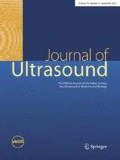Abstract
Incisional hernias commonly develop after abdominal surgeries with a lower incidence in patients receiving laparoscopy. Diagnosis through a non-surgical approach is usually made by computed tomography or magnetic resonance images (MRI) but both image modalities require patients to be examined in a supine position. We reported a case noticing a mass over her right lower abdomen after a laparoscopic liver segmentectomy with negative findings of hernia on MRI. A hernia sac was found by ultrasound with the patient being standing, highlighting the utility of dynamic ultrasound with postural change in investigation of incisional hernias.
Sommario
Il laparocele dopo interventi di chirurgia addominale si realizza con minore incidenza nei pazienti trattati con laparoscopia. La diagnosi non chirurgica di solito è fatta contomografia computerizzata o risonanza magnetica (MRI), ma entrambe le modalità richiedono che i pazienti siano esaminati in posizione supina. Presentiamo un caso di massa del basso addome, a destra, dopo segmentectomia epatica laparoscopica, con risultati negativi per ernia all’esame 24 MRI. L'ecografia, con paziente in piedi, ha evidenziato un sacco erniario, dimostrando l'utilità dell'ecografia dinamica, con cambio posturale, nelle indagini per laparocele.



References
Le Huu Nho R, Mege D, Ouaissi M, Sielezneff I, Sastre B (2012) Incidence and prevention of ventral incisional hernia. J Visc Surg 149(5 Suppl):e3–e14
Tonouchi H, Ohmori Y, Kobayashi M, Kusunoki M (2004) Trocar site hernia. Arch Surg 139(11):1248–1256
Hojer AM, Rygaard H, Jess P (1997) CT in the diagnosis of abdominal wall hernias: a preliminary study. Eur Radiol 7(9):1416–1418
Musella M, Milone F, Chello M, Angelini P, Jovino R (2001) Magnetic resonance imaging and abdominal wall hernias in aortic surgery. J Am Coll Surg 193(4):392–395
Sanz-Lopez R, Martinez-Ramos C, Nunez-Pena JR, Ruiz de Gopegui M, Pastor-Sirera L, Tamames-Escobar S (1999) Incisional hernias after laparoscopic vs open cholecystectomy. Surg Endosc 13(9):922–924
Seiler CM, Diener MK (2010) Which abdominal incisions predispose for incisional hernias? Chirurg 81(3):186–191
Comajuncosas J, Hermoso J, Gris P, Jimeno J, Orbeal R, Vallverdu H, Lopez Negre JL, Urgelles J, Estalella L, Pares D (2013) Risk factors for umbilical trocar site incisional hernia in laparoscopic cholecystectomy: a prospective 3-year follow-up study. Am J Surg 207(1):1–6
Paolucci V, Schaeff B, Schneider M, Gutt C (1999) Tumor seeding following laparoscopy: international survey. World J Surg 23(10):989–995 (discussion 996–987)
Yeh HC, Lehr-Janus C, Cohen BA, Rabinowitz JG (1984) Ultrasonography and CT of abdominal and inguinal hernias. J Clin Ultrasound 12(8):479–486
den Hartog D, Dur AH, Kamphuis AG, Tuinebreijer WE, Kreis RW (2009) Comparison of ultrasonography with computed tomography in the diagnosis of incisional hernias. Hernia 13(1):45–48
Jamadar DA, Jacobson JA, Morag Y, Girish G, Dong Q, Al-Hawary M, Franz MG (2007) Characteristic locations of inguinal region and anterior abdominal wall hernias: sonographic appearances and identification of clinical pitfalls. AJR Am J Roentgenol 188(5):1356–1364
Bloemen A, van Dooren P, Huizinga BF, Hoofwijk AG (2011) Comparison of ultrasonography and physical examination in the diagnosis of incisional hernia in a prospective study. Hernia 16(1):53–57
Erdas E, Dazzi C, Secchi F, Aresu S, Pitzalis A, Barbarossa M, Garau A, Murgia A, Contu P, Licheri S, Pomata M, Farina G (2012) Incidence and risk factors for trocar site hernia following laparoscopic cholecystectomy: a long-term follow-up study. Hernia 16(4):431–437
Conflict of interest
Patcharaporn Wongsithichai, Ke-Vin Chang, Chen-Yu Hung, and Tyng-Guey Wang declare that they have no conflict of interest.
Ethical standards
All procedures followed were in accordance with the ethical standards of the responsible committee on human experimentation (institutional and national) and with the Helsinki Declaration of 1975, as revised in 2008. Informed consent was not necessary since there is no identifying information in this case report.
Author information
Authors and Affiliations
Corresponding author
Rights and permissions
About this article
Cite this article
Wongsithichai, P., Chang, KV., Hung, CY. et al. Dynamic ultrasound with postural change facilitated the detection of an incisional hernia in a case with negative MRI findings. J Ultrasound 18, 279–281 (2015). https://doi.org/10.1007/s40477-014-0146-x
Received:
Accepted:
Published:
Issue Date:
DOI: https://doi.org/10.1007/s40477-014-0146-x

